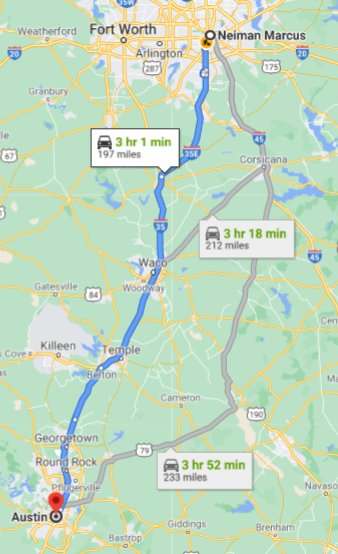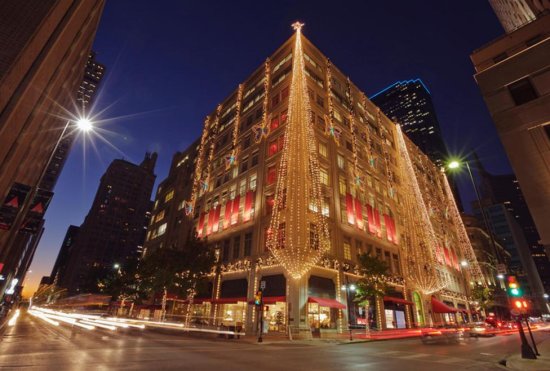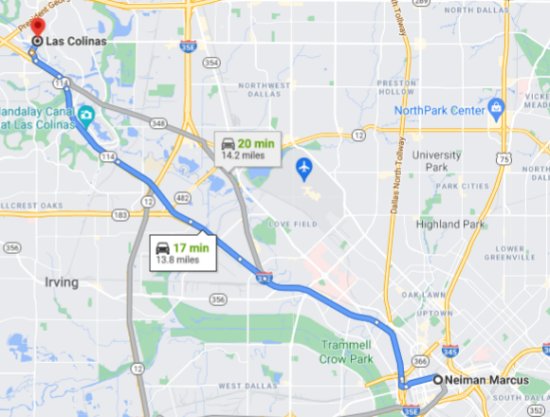The store with only two sales per year. Continue reading
My recollection is that the first inquiry from Neiman Marcus came in early 1992 On the other end of the phone line was the manager of the advertising business office. Although I worked with her pretty closely for a fairly extensive period of time, I don’t remember her name.
She must have responded to a mass mailing that I sent after the installation at Hecht’s was under control. I addressed those letters to advertising directors. So, the advertising director must have given it to her. In our telephone conversation she explained to me how they did things at Neiman’s. I told her that I thought that our system could help her with some of their problems. I then sent her materials about how AdDept worked and tried to relate aspects of AdDept to Neiman’s situation.
She asked us to pay them a visit. I arranged for Sue Comparetto and me fly to Dallas to meet with the potential users and to do a demonstration for them at IBM’s local office. The business office of Neiman’s advertising department was on one of the upper floors of the company’s flagship store on Main Street.
When we arrived there I was surprised to find that the rest of the advertising department would not be involved in the discussion. Although Neiman Marcus was still using the system in 2014, I never spoke with anyone from the rest of the department. They used an advertising agency for most of their advertising, including newspaper ads. In fact, the lady that we were dealing with did not even want the rest of the department to have access to the system. She really just wanted a system to keep track of expenses and co-op.
The stores only had two sales per year— First Call in February and Last Call in August, or maybe the other way around. They used the traditional 4-5-4 retail calendar (described here) with which we were already familiar, but Neiman’s first month was August, not February.
My AdDept demo needed a major change of emphasis. I usually emphasized that the main reason for a centralized database was for everyone to take advantage of work done by others. She did not want the others involved at all. Also, the most impressive part of the demo was how quickly a newspaper ad could be scheduled. She had little interest in that task, which was the agency’s responsibility. Nevertheless, the reaction to what I showed was quite positive.
After the demo Sue and I rented a car and drove to Austin for a little R&R with Marlene Soul, one of her friends from high school. She was, if you can believe it, a consultant in feng shui, which she claimed was mostly about being organized.
Marlene took us to a comedy club in downtown Austin, which was definitely a swinging place. I also remember sitting around at her house while she tortured her cat with a long flexible semi-rigid wire that ended with a feather. The slightest twitch made the feather jump and fly.
I made a note to myself to buy one of these when I arrived back in New England so that I could use it to drive my cantankerous cat Woodrow crazy. I did, and it did. He had to hide under the couch so that he could not see it.
The following morning we went birding with Marlene and a group that met every Saturday morning. I was exceptionally bad at it. I have had poor vision since the third grate, and I have always been notoriously bad at finding things anywhere. However, this gathering did spark enough interest in me to become a little more knowledgeable in ornithology.
Upon returning to the office I spent a couple of days putting together a detailed proposal for Neiman Marcus. It did not include as much custom programming as usual. The main objective was for the AS/400 to be able to generate a file to be used by the expense payable system on the mainframe.
The business office manager accepted the proposal a short time after receiving it. I sent her a software contract, which she signed. I then ordered the hardware and system software from IBM and we received an installation date. I knew that we would not have the interface done by then, but we would need some data to test the interface anyway, and there would be no data on day one.
From our perspective this was by far the easiest sale that we had ever had, and the installation, which took place in August of 1992, also went rather smoothly. I had to spend quite a bit of time fine-tuning the coding for the incredibly complicated interface with their corporate financial system. I did not care. I loved to do that kind of work because, once it was in place, the chances of them scrapping the system were minuscule1.
People in the IT department2, however, were furious that the lady from the advertising business office had signed a contract with TSI without consulting them. They were nice enough to me, and they were quite cooperative about establishing the interface between the two systems. However, her career at Neiman Marcus did not last long after AdDept was installed and working smoothly.
The key to the success of the installation was effecting the financial interface. It involved a considerable amount of two-way communication between AdDept and the corporate mainframe. Gary Beberman, who had been TSI’s liaison for the first AdDept installation at Macy’s East (described here), was extremely effective as the go-between for TSI and the mainframe programmers.
I found this list of the steps involved in a document written in 2000:
1. A list of general ledger accounts is downloaded. AdDept’s general ledger account table is updated.
2.A list of departments with the accompanying hierarchy is downloaded. The department table and the rest of the hierarchy is updated.
3. Expenses are uploaded to the accounts payable system. The accounts payable system feeds the general ledger.
4. Co-op transactions are also uploaded to the accounts payable system. The accounts payable system feeds the general ledger.
5. General ledger transactions in the advertising accounts are downloaded at the end of the month. An AdDept program compares the downloaded transactions with the uploaded transactions. A list of exceptions is printed. Additional transactions are placed in a batch file, which can be converted to real AdDept transactions.
I made a fairly large number of visits to Dallas during the installation period. Thereafter, a few years would sometime go by between requests for visits. Here are a few memories that I have maintained of those trips.
- In the nineties I spent a lot of time in the American Airlines section of the DFW airport. My favorite restaurant there was a Mexican cantina.
- I also spent a lot of in autos driving between the airport and either Dallas or Fort Worth, where TSI had several clients. Sometimes I took a cab; usually I rented a car from Avis.
- On my first solo trip to Neiman’s I was a little late and a little lost. I crossed Main Street in the middle of the street. A cop stopped me with every intention of giving me a ticket for jaywalking. I was polite, however, and he let me go with only a warning.
- One of my early visits was in December during the running of the Dallas Marathon. I went out for a jog and watched some of the real runners near the finish line. This must have been on a Saturday or a Sunday.
- The temperature on that day was around 30. I was wearing stretch leggings, shorts, a tee shirt, and a nylon jacket. Most of the real runners were wearing shorts and singlets. At Neiman’s on Monday the business manager, who was a originally from Pittsburgh, confided to me that she and her husband were concerned about whether the cold weather might harm their child if they let her play outside. She admitted that no one in Pittsburgh would have thought twice about their kids being out for hours in such weather.
- On another occasion I walked to the State Fair grounds on a Friday evening. I was surprised to discover thousands of people celebrating Juneteenth. I had never heard of this event before.
- One summer evening after working at Neiman’s I took a stroll down to Dealey Plaza, which is the the location of the ramp to I-35. I wanted to conduct a personal investigation of the interchange, the “grassy knoll”, the Texas Book Depository (which had been converted into a museum), and the other locations associated with the assassination. A few minutes earlier the fatal presidential motorcade had passed right by Neiman’s flagship store, which is .6 miles from the plaza.
- One day after the system was operational the business office manager drove me to lunch for some authentic Texas barbecue. I cannot say that I was very impressed. I have never understood the idea of cooking all of the flavor out of meat just so it could be coated with barbecue sauce.
- Neiman’s made a big deal out of Christmas. Not only did they publish their famous catalog with one outrageous gift idea, but they also sponsored an evening in which their VIP clients could shop without dealing with the riffraff. The store open that evening only to those who were sent an invitation. Each was assigned an employee to tour the store with them. I am not sure what the employees were expected to do. I looked for members of the Ewing family, but I did not see any.
- On my visit on September 9, 2000, the temperature reached 109°. It was also the thirty-fifth day in a row with no rain. That was the day that I understood why the streets in Texas are almost all concrete, as opposed to asphalt. Anything that was paved with asphalt turned gooey when the temperature got that high.
I did not actually work with most of the subsequent Neiman’s employees enough to burn in lasting memories. I did find some notes that provided me with some information on some of them;
- I was surprised to discover that many of the successors to the female business office manager mentioned above were Aggies, that is, graduates of Texas A&M. The first was Jeff Netzer3, who worked at Neiman’s from 1996-1999. He called TSI a few years later when he was employed at Sewell Automotive Company. I saw Jeff there when they invited me to assess the possibility of us designing a system for this company. This experience is described here.
- The second Aggie was named Brian Harvey4. He worked in the advertising department from 1998-2000. I met him in 2000, but I don’t remember him.
- After Brian’s departure the advertising business office was run by Alea Montez. I remember that she called the office for support several times. I don’t think that I ever met her.
- The last Aggie was Brian Davis5, whose title at Neiman’s was Media Analyst. I don’t remember him at all. I don’t think that I ever met him in person.
- A striking omission in this list is everyone in any other area of advertising. I never succeeded in interesting anyone in even considering what TSI had done for so many others in similar positions.
- I had quite a bit of contact with a number of IT people at Neiman’s. I met a few in person, but I don’t remember any names.
- In the 2000’s Neiman’s hired an AS/400 consultant to help them with connectivity and to upgrade their system. We had a good relationship with him, but I don’t remember his name.
1. In fact, the AdDept installation at Neiman’s lasted longer than that of any other client. Part of the explanation for that was that Neiman’s was one of the few AdDept clients that was not bought out by another company. When we closed TSI’s doors for the last time in 2014, Neiman’s was still using AdDept. For all that I know, it may have continued after that.
2 The IT people worked in a building in Las Colinas, a few miles from the flagship store in downtown Dallas. I went there a couple of times and met a few people there.
3. Jeff Netzer’s LinkedIn page is here.
4. Brian Harvey’s LinkedIn page is here.
5. Brian Davis’s LinkedIn page is here.







